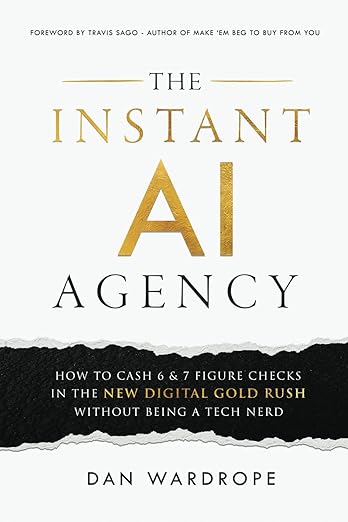“The Instant AI Agency” by Dan Wardrope
Who is it for? For entrepreneurs and marketers keen to harness AI-driven business models in the digital marketing world.
Dan Wardrope’s “The Instant AI Agency” is a fresh and relevant guide for those eager to build a digital marketing agency leveraging AI. The book provides a practical roadmap to creating and scaling an AI-powered agency, offering insights into the latest tools, strategies, and mindsets needed to thrive in today’s fast-paced digital landscape.
Wardrope, an experienced digital marketer, uses a clear and straightforward approach to introduce readers to the concept of building an AI-driven business from scratch. The book focuses on how automation and AI can revolutionise client acquisition, streamline operations, and ultimately allow agencies to scale more efficiently. By demystifying AI, Wardrope makes it accessible to both seasoned marketers and newcomers alike.
The book is built around key techniques that include selecting the right AI tools, creating high-conversion funnels, and establishing scalable systems. Wardrope explains how AI can automate much of the repetitive work in client management, freeing up time for more strategic efforts. He also touches on using AI to gather and interpret data, which is crucial for making informed marketing decisions. His examples and case studies provide practical insight into how AI can be applied across different industries.
One of the challenges readers may face is understanding the evolving nature of AI technologies and integrating them into their agency’s specific needs. Wardrope’s emphasis on automation and streamlining processes might oversimplify the challenges of maintaining personal client relationships and customising services in a competitive market.
Another hurdle is that while Wardrope effectively presents a compelling case for starting an AI agency, the book might not dive deeply enough into the technical side of AI for those who are already familiar with the field. Readers looking for detailed technical guidance may find themselves wanting more in-depth coverage of AI tools and technologies.
“The Instant AI Agency” also presupposes that the reader has some familiarity with digital marketing, and its practical advice might feel overwhelming to absolute beginners. However, Wardrope’s emphasis on AI’s transformative power, combined with his actionable strategies, makes this book highly valuable for those ready to take their agency to the next level.
In summary, “The Instant AI Agency” provides a timely and practical guide to building a digital marketing agency equipped for the future. It offers useful, actionable insights, especially for entrepreneurs looking to embrace AI’s potential, but readers may need additional resources to fully implement its principles, particularly in more complex or specialised agency settings. For marketers aiming to innovate and stay ahead in a rapidly changing field, Wardrope’s book is a worthwhile read.

